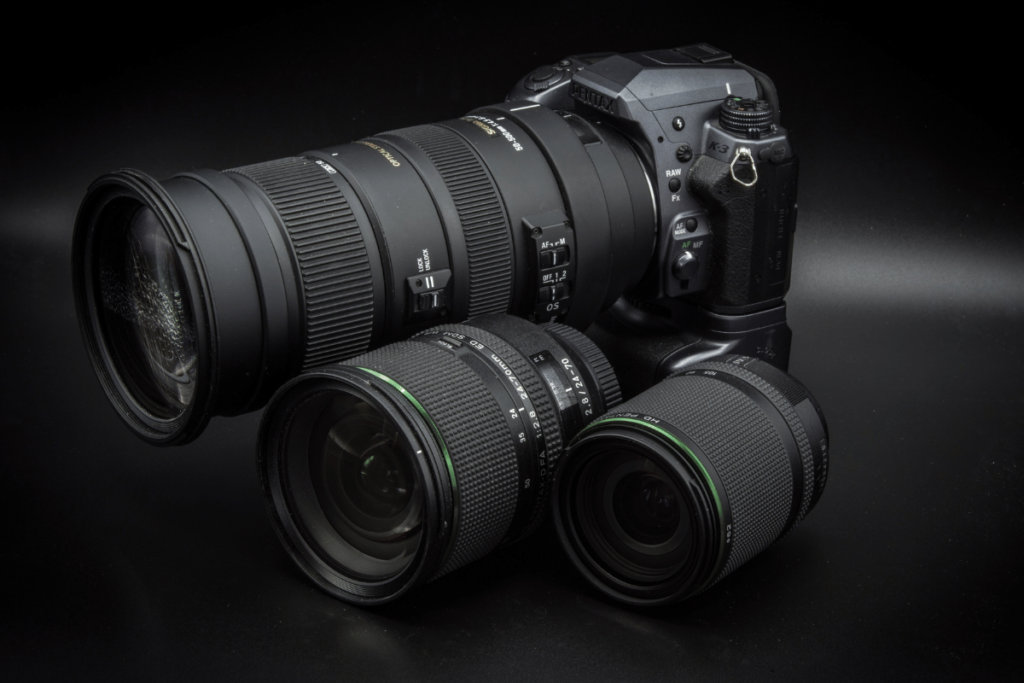
In this article, you’ll find out exactly how much a mirrorless camera weighs. You’ll also see how it stacks up against its bulkier DSLR cousins. We’ll explore the factors that affect their weight. We’ll also explore the advantages of going lighter for your photography adventures.
Average Weight of Mirrorless Cameras
When you’re grappling with the decision of which camera to buy, weight plays a crucial role. You’ll be excited to learn that mirrorless cameras have slim bodies. They tip the scales in your favor.
Body Material & Sensor Size Impact
Mirrorless camera bodies are often made from lightweight alloys. This magnificently shaves off ounces. Compact sizes don’t require the heft that their DSLR counterparts do. Then there’s the sensor size – the heart of the camera. A larger sensor could add a bit of weight, but hey, that’s the price for those phenomenal images.
The Battery and Lens Equation
Batteries are the unsung heroes, often the lifeline on long shoots. Although necessary, they can weigh your gear down. Let’s chat about those lenses. The mount and glass will inevitably affect the final weight. This is true whether you’re packing a small prime or a larger zoom.
From Featherweights to Heftier Models
Feast your eyes on this table comparing the weight of various mirrorless models:
| Brand & Model | Weight (g) |
|---|---|
| Featherlight Alpha | 350 |
| Medium Migonette | 450 |
| Heftier Halide | 600 |
Some mirrorless cameras, like the Featherlight Alpha, weigh close to 350g. It’s like carrying a can of soda. Then there’s the Medium Migonette, sitting comfortably at 450g. It’s still less than a good sandwich. The Heftier Halide weighs 600g, but offers robust features. This trade-off may be worth it for those who don’t mind a little workout.
Whether you’re scaling mountains or capturing the hustle of city streets, knowing the weight you’re carrying can free you up. It allows you to focus on snagging that perfect shot. With mirrorless camera weight, you’re wielding less bulge and more brilliance.
Wouldn’t you prefer to schlep around with a lightweight champ? Instead, are the bulky beast that leaves you with sore shoulders? You betcha.
Weight Comparison of Mirrorless Cameras with DSLRs and Point-and-Shoot Cameras
DSLRs: The Weighty Contenders
When you’re considering buying a camera, one of the first things you’ll notice is the heft. DSLRs are the traditional big guns of the photography world. They have larger bodies and mirrored mechanics. They often come with a significant weight penalty. Typically, a DSLR with a standard lens can weigh anywhere from 1.5 to 3 pounds. That’s a noticeable difference. This is especially true when you carry it around all day on your neck or in your bag.
Mirrorless Cameras: The Lightweights
In contrast, mirrorless camera weight has been a game changer. Photographers who value portability love it. The absence of the mirror box and optical viewfinder not only makes these cameras more compact but also lighter. Even with a similar lens, an average mirrorless camera can weigh up to 40% less than its DSLR counterpart. Who wouldn’t want to lighten their load without sacrificing quality?
Point-and-Shoot Cameras: Featherweights
If you really want to go as light as possible, point-and-shoot cameras tip the scales at an even lesser weight. These cameras can be as light as 0.25 to 0.5 pounds, making them the ultimate choice for slipping into your pocket. They’re perfect when you’re on the move and don’t want the fuss of changing lenses or managing extra gear.
Weighing Performance and Functionality
But weight is just one facet. Sure, a lighter camera is great for travel and long shoots. However, a heavier DSLR might hold its ground better. It has superior battery life and dependability in extreme weather. Then again, the lighter mirrorless camera weight offers nimbleness for street and sports photography. It’s a toss-up and all about your shooting style and needs.
Let’s look at it in a table to get a clearer picture:
| Camera Type | Average Weight (lbs) |
|---|---|
| DSLR | 1.5 – 3 |
| Mirrorless | 0.9 – 1.7 |
| Point-and-Shoot | 0.25 – 0.5 |
– Importance of weight in specific scenarios
Travel Photography
When you’re traveling the world, you don’t want heavy gear to slow you down. You’re capturing the essence of each place, from busy markets to peaceful landscapes. That’s where mirrorless camera weight shines. It allows you to be nimble and discreet—a boon for nabbing those fleeting cultural gems.
Wildlife Photography
Out in the wild, every ounce counts. You’re there to document nature’s marvels without being a disturbance. A clunky camera simply won’t do. Mirrorless cameras are lighter. They make it easier to trek through forests and set up shop unnoticed. They’re quiet, too, less likely to startle your subjects.
Street Photography
Capturing the raw pulse of city life calls for a camera that’s as fluid as the streets are unpredictable. The lack of weight in a mirrorless camera helps you blend into shadows and silhouettes. You can snap that decisive moment. Its unobtrusive nature means you’re part of the scene, not an outsider looking in.
Tips for reducing weight when using a mirrorless camera
Choosing Lighter Lenses
Let’s talk glass. When you’re trying to shave off ounces from your kit, every little bit helps. But, of course, you don’t want to sacrifice those crisp, vibrant shots. The key? Balancing lens weight with performance. You’ll want to consider the trade-offs.
For example, a lens’s aperture capability and optical stabilization versus its heft. For instance, a monster lens with f/2.8 and image stabilization is great. But, do you really need it for your jaunt around the city?
Here’s a fun fact: Prime lenses often weigh less than zoom lenses. They can also add serious quality to your shots. And don’t forget about the pancake lenses—these slim jimmys pack a punch without the paunch. Kit lenses that come with your camera are typically lightweight and versatile. This makes them a great starting point.
Exploring Lightweight Accessories
Accessories can make or break your shoot and your back. You don’t need to haul everything but the kitchen sink. A couple of extra batteries and memory cards will usually do the trick. Choose lightweight filters. Consider a travel tripod that’s more “spider” than “octopus” in size.
When the lighting just won’t cooperate, a compact flash can be a lifesaver. It won’t weigh you down. What about keeping everything organized? Opt for pouches and dividers that weigh next to nothing but can save you from a tangled mess.
Keeping it light means keeping it tight. Choose your accessories wisely. You’ll barely notice they’re there, except when they’re saving your shot. Who knows? With fewer items, you might catch something you would have missed. Rummaging through a bag full of gizmos.
Conclusion
So you’ve seen how a mirrorless camera can lighten your load. And it doesn’t sacrifice quality. Your camera’s weight plays a pivotal role in your journey. Whether you’re trekking through cities or scaling mountains for that perfect shot. Embrace the freedom of going lighter and let your photography soar. Happy shooting!
Frequently Asked Questions
What is the average weight of mirrorless cameras compared to DSLRs?
Mirrorless cameras are significantly lighter, typically ranging from 0.9 to 1.7 pounds, whereas DSLRs are bulkier.
Are point-and-shoot cameras lighter than mirrorless cameras?
Yes, point-and-shoot cameras are lighter, generally weighing around 0.25 to 0.5 pounds.
What factors aside from weight should I consider when choosing a camera?
You should consider battery life and weather resistance, among other features, when selecting a camera.
Can the weight of a mirrorless camera be reduced further?
Yes, you can reduce the weight by opting for lighter lenses and exploring lightweight camera accessories.
How do I select travel-friendly camera gear?
Choose gear that balances weight with performance and is comfortable and secure for travel photography.

